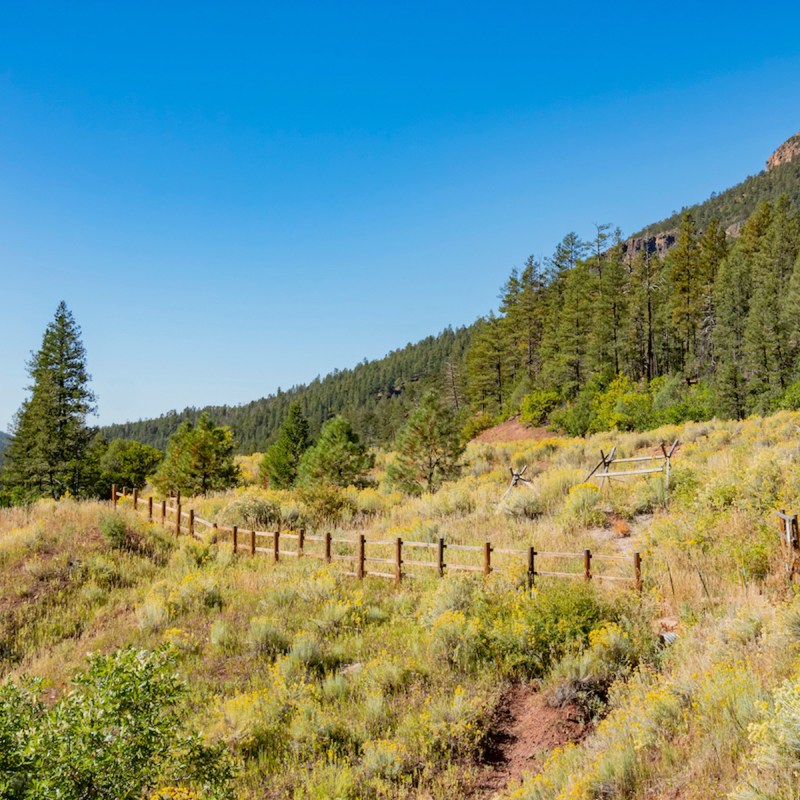
I had never heard of Valles Caldera (pronounced VIE-yays kall-DAIR-uh) until I overheard a conversation in a Santa Fe restaurant. After hearing what the people said, I tossed aside other itinerary items to see New Mexico’s hidden gem.
Videos by TravelAwaits
Before I went to the preserve, I filled up the car and bought lunch and bottled water in Los Alamos, home of the Manhattan Project. The preserve has little water available and is over 8,000 feet in elevation. Water is a must to prevent dehydration and altitude sickness. Since the nearest gas station is in Los Alamos 20 miles away, so is a full tank.
Based on the park service’s directions, I drove Jemez (pronounced HAY-mez) Road, which passes through Los Alamos National Laboratory (LANL). Your phone or GPS is likely to steer you in the wrong direction. At the LANL checkpoint, the officer politely asked for my driver’s license and my destination. When I said Valles Caldera, he said I would enjoy it.
The momentary inconvenience along Highway 4 was repaid when I saw the caldera for the first time. I gasped in awe. A gorgeous green bowl with a low dome poking out spread out before me. Deep green trees on the slopes gave way to lighter green grasses and late wildflowers. Grass-covered meadows are called valles in Spanish. (Because of the preserve’s steep elevation grade, the caldera’s floor experiences severe winters that are too cold for trees.)
My first thought: Why is this place not better known? My second thought: Hooray! What a peaceful experience this will be!
I pulled into a turnout to catch my breath and further examine the scenery. I had made the correct decision to dump my itinerary based on a half-heard conversation.

1. Safely Enter A Volcano’s Mouth
The preserve’s placid appearance disguises a turbulent past. Three young supervolcanoes exist in the United States. Valles Caldera is the oldest of the three, which include Yellowstone in Wyoming and Long Valley, California. The Valles Caldera exploded 1.25 million years ago. Ring fractures created a 12- by 14-mile depression in the earth. The spectacular collapse was not the final volcanic temper tantrum. Eruptions continued until approximately 40,000 years ago, forming domes and lakes. Some of the domes look like giant pimples. Some of them are high enough to be mountains. Redondo Peak is the highest of the Jemez Mountains at 11,253 feet.
The caldera’s rocks helped prove the theory of plate tectonics in the 1960s.
Pro Tip: While a volcanic eruption is unlikely, be aware of other hazards. Follow the preserve’s safety tips.
2. Drive Or Ride The Backcountry
Arrive when the visitors center opens at 8 a.m. if you intend to drive or ride your horse in the preserve’s backcountry because the preserve limits backcountry permits. Permits are only available from mid-May through October and are only valid during operating hours on the date of issue. Hikers, bikers, skiers, and snowshoers can enter the backcountry without permits.
Because access is limited, the backcountry offers the best opportunity to see wildlife and wildflowers. Watch for members of New Mexico’s second-largest elk population. Also, look for badgers, black bears, Eastern mountain bluebirds, and golden eagles.
Prepare for some driving challenges. The roads are dirt and erode during rainy weather. I drove a small passenger car, but I recommend a high-clearance vehicle. I was alone, but I recommend bringing another person to watch for obstacles. Yes, I had some narrow misses. Anglers should fish for trout in Jaramillo and San Antonio Creeks. Buy a New Mexico fishing license and a preserve permit.
Pro Tip: Download and print the Backcountry Driving Companion. Cell service is unreliable.

3. Explore The Cabin District
The Cabin District is 4 miles from the visitors center. Parking is available for those with a driving permit. Even without a vehicle, it’s a relatively easy hike. Five historic buildings are here, plus the Valle Grande Contact Station. Netflix filmed the Longmire series at the Ranch Foreman’s Cabin. The cabins are very picturesque and fun to photograph. Make sure to include any wildflowers in your images. However, please stay off the porches and don’t try to enter the buildings.
Pro Tip: Longmire was the 11th movie or TV series filmed within the caldera, and some of the movie sets are still visible.
4. Step Into Profound Silence In History Grove
History Grove is about 4.5 miles from the main gate. When I stepped into the 125-acre old-growth forest, a cone of silence dropped around me. Even my thoughts calmed as I took in the soft sounds of the forest around me. The ponderosa pines and Douglas firs are between 250 to 400 years old. They represent a portion of the small range of old-growth forests remaining in the United States.
Walking in the forest is like walking in an ancient cathedral, a place of deep reverence. The aroma of the pines and firs enveloped me with calm.

5. Hike the Cerro La Jara Loop Trail
If time is severely limited or you missed out on the daily vehicle permit, hike the La Jara Trail. It’s an easy 1.5-mile hike around one of the “pimple” domes, looping from the visitor center. Stretch your legs and walk your dog. When I hiked it, the small visitor center parking lot was full, but I didn’t see another hiker. I saw a coyote, but no other wildlife. The prairie dog colony was curiously silent. I loved the Valle Grande and South Mountain views, plus the numerous late summer wildflowers.

6. Find The Hidden Valley And The Missing Cabin
About half a mile from the gate, climb a hill to a movie-set cabin. The cabin overlooks the Valle Grande and Hidden Valley. The view stretches 9 miles to the caldera’s eastern rim. Continue the easy Hidden Valley Trail into the Jemez River’s canyon as it flows toward South Mountain.
Walking through knee-high grass makes a lovely swishing sound, but protect your legs with bug repellent.
7. Explore A Forested Moonscape On The Banco Bonito Loop
Banco Bonito Loop is a 9.2-mile hike through a moonscape above the flat caldera bottom. Lava flows have turned the landscape into rock lumps, punctuated by tall, straight Ponderosa pines, a bizarre combination. The trail passes El Cajete Meadow. El Cajete means “shallow bowl,” and the locals raced horses there. Hike the moderate trail counterclockwise, and rejoice in the shade below the ponderosas. To add mileage, walk around the meadow.
8. Own The Night Under Some Of The World’s Darkest Skies
The International Dark Sky Association named Valles Caldera an International Dark Sky Park in 2021. Currently, Highway 4’s pullouts offer the only nighttime access points, but the park is working on expanding access. The preserve typically holds astronomy events monthly from May to September. Follow the preserve’s social media accounts for event updates.
Pro Tip: Florissant Fossil Beds on the Gold Belt National Scenic Byway and the Black Canyon of the Gunnison National Park are also Dark Sky Parks.
9. Whisper In The Winter Sounds Of Silence
When winter’s shadows are long and the snow is deep, ski and snowshoe in Valles Caldera. The preserve’s best cross country skiing comes on the preserve’s north slopes, but the entire preserve is open for Nordic skiing. Bring skis and poles with large baskets and wear waterproof pants.
If you know how to hike, you can snowshoe. All you need are snowshoes, waterproof boots, pants, and poles. The preserve’s bookstore has some snowshoes and poles to rent.
The preserve does not groom the trails, and winter visitation is low.
Do you hear the sound of silence?
10. Hot Springs Eternal At Valles Caldera
In 2020, the preserve acquired the 40-acre Sulphur Springs on the preserve’s western edge. The massive caldera already made the preserve like Yellowstone National Park. Adding the Sulphur Canyon site completes the process. The Sulphur Springs area includes steaming mud pots, sulfuric-acid hot springs, and fumaroles, volcanic openings that emit hot, sulfuric gases.
The National Park Service is currently preparing the hot springs area for visitors by cleaning up mining debris and installing safety features. Until the process is complete, visitation will remain limited.

Pro Tips
If you’re based in Santa Fe as I was, stop at the White Rock Overlook on your return. Don’t worry when you see several ballfields on the road; you are in the right place. The road ends at the overlook. For the second time that day, my jaw dropped in awe. The view is 270 degrees of amazement as you gaze at the Rio Grande River below. Arrive shortly before sunset for the best images.
My route to the overlook skirted Bandelier National Monument. The Swiss cheese rocks I saw on the roadside were the Bandelier Tuff. That’s the volcanic rock that ejected from the Valles Caldera.
The Blue Dot and Red Dot Trails head into the canyon, while the White Rock Canyon Rim Trail offers superb views topside. Rock climbers may try the Gallows Edge.
